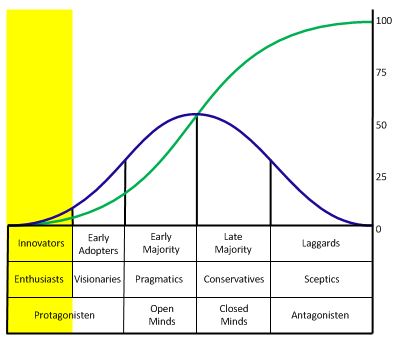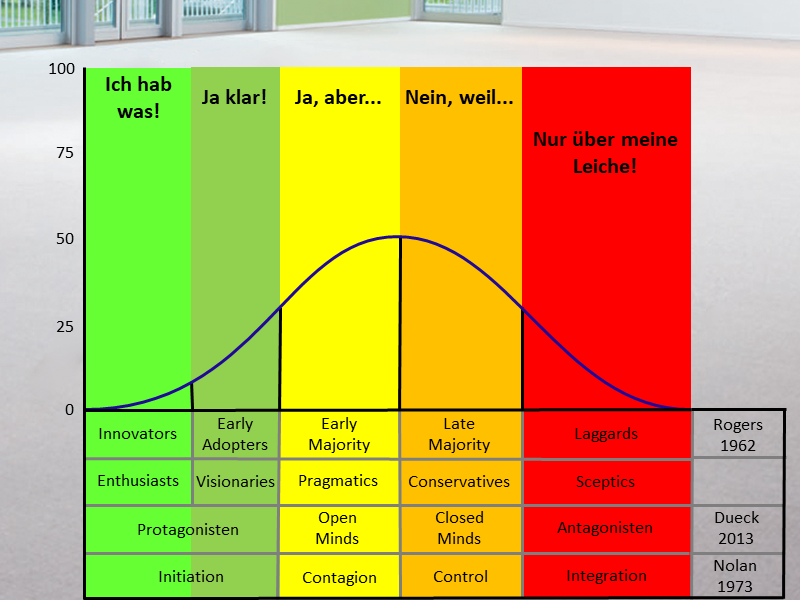innovator innovator |

|
 Diese Seite wurde seit 1 Jahr inhaltlich nicht mehr aktualisiert.
Unter Umständen ist sie nicht mehr aktuell.
Diese Seite wurde seit 1 Jahr inhaltlich nicht mehr aktualisiert.
Unter Umständen ist sie nicht mehr aktuell.
 Definitionen
Definitionen
The first people to adopt a new idea are innovators.
They adopt ahead of other people.
Von Joe M. Bohlen, George M. Beal im Text The diffusion process (1957)  Innovatoren (Innovators) bringen Neues in eine Organisation, indem sie viel Zeit für eigene Experimente und visionäre Ideen aufwenden. Sie testen auch unfertige Konzepte und Produkte. Ihr Leitmotiv lautet : »Ich habe da was Neues gefunden!«
Innovatoren (Innovators) bringen Neues in eine Organisation, indem sie viel Zeit für eigene Experimente und visionäre Ideen aufwenden. Sie testen auch unfertige Konzepte und Produkte. Ihr Leitmotiv lautet : »Ich habe da was Neues gefunden!«
 Innovatoren (innovators) sind im Vergleich zu anderen Personen besonders experimentierfreudig
und testen gerne neue Konzepte, Methoden und Technologien.
In der Schule sind dies solche Lehrpersonen, die neue Technologien schon lange
vor allen anderen in ihrem Unterricht ausprobieren (Leitmotiv: „Ich hab’ da was
Neues gefunden“).
Innovatoren (innovators) sind im Vergleich zu anderen Personen besonders experimentierfreudig
und testen gerne neue Konzepte, Methoden und Technologien.
In der Schule sind dies solche Lehrpersonen, die neue Technologien schon lange
vor allen anderen in ihrem Unterricht ausprobieren (Leitmotiv: „Ich hab’ da was
Neues gefunden“). Innovators pursue new technology products aggressively. They sometimes
seek them out even before a formal marketing program has been launched.
This is because technology is a central interest in their life, regardless of what
function it is performing. At root they are intrigued with any fundamental
advance and often make a technology purchase simply for the pleasure of
exploring the new device’s properties. There are not very many innovators in
any given market segment, but winning them over at the outset of a marketing
campaign is key nonetheless, because -their endorsement reassures the
other players in the marketplace that the product does in fact work.
Innovators pursue new technology products aggressively. They sometimes
seek them out even before a formal marketing program has been launched.
This is because technology is a central interest in their life, regardless of what
function it is performing. At root they are intrigued with any fundamental
advance and often make a technology purchase simply for the pleasure of
exploring the new device’s properties. There are not very many innovators in
any given market segment, but winning them over at the outset of a marketing
campaign is key nonetheless, because -their endorsement reassures the
other players in the marketplace that the product does in fact work. Rogers untersuchte schon 1962 in seinem Buch Diffusion of Innovations die Ausbreitung von Innovationen in einer Bevölkerung. Zuerst gibt es die Idee oder Vision eines Erfinders oder Innovators, dann bauen Innovatoren erste Prototypen, die schon von den ersten technisch Interessierten (»Early Adopters« oder »Erstanwender«) benutzt werden. Diese ersten Anwender verbessern entweder selbst oder durch konstruktive Kritik die ersten Prototypen, sodass die neue Erfindung langsam reift und schließlich so gut wird, dass sie die fortschrittlich denkende »erste Hälfte« der Menschen nützlich findet. Jetzt erst ist aus der Erfindung eine wirkliche Innovation geworden. Die »Pragmatics« haben die Innovation für sich selbst als nützlich akzeptiert! Die konservative Hälfte der Menschen freundet sich mit der Innovation erst später oder viel später an, ein letzter Rest vielleicht nie (»Ich bin stolz, jetzt schon seit 50 Jahren keinen Fernseher zu besitzen.«).
Rogers untersuchte schon 1962 in seinem Buch Diffusion of Innovations die Ausbreitung von Innovationen in einer Bevölkerung. Zuerst gibt es die Idee oder Vision eines Erfinders oder Innovators, dann bauen Innovatoren erste Prototypen, die schon von den ersten technisch Interessierten (»Early Adopters« oder »Erstanwender«) benutzt werden. Diese ersten Anwender verbessern entweder selbst oder durch konstruktive Kritik die ersten Prototypen, sodass die neue Erfindung langsam reift und schließlich so gut wird, dass sie die fortschrittlich denkende »erste Hälfte« der Menschen nützlich findet. Jetzt erst ist aus der Erfindung eine wirkliche Innovation geworden. Die »Pragmatics« haben die Innovation für sich selbst als nützlich akzeptiert! Die konservative Hälfte der Menschen freundet sich mit der Innovation erst später oder viel später an, ein letzter Rest vielleicht nie (»Ich bin stolz, jetzt schon seit 50 Jahren keinen Fernseher zu besitzen.«). Bemerkungen
Bemerkungen
Since they have more formal and informal associations
outside the community than most other community
members, they have more potential sources of information.
Von Joe M. Bohlen, George M. Beal im Text The diffusion process (1957)  Innovatoren
und Early Adopter brauchen keine Förderung. Sie sind bereits
glücklich, wenn ihnen keine Steine in den Weg gelegt werden
und sie Freiraum, Verständnis und Interesse für ihre unzeitgemäßen
Ideen erhalten.
Innovatoren
und Early Adopter brauchen keine Förderung. Sie sind bereits
glücklich, wenn ihnen keine Steine in den Weg gelegt werden
und sie Freiraum, Verständnis und Interesse für ihre unzeitgemäßen
Ideen erhalten.They are active in the community. They have power.
They may not hold many offices in the community, but
they may act behind the scenes. For instance, they may
not be members of the school board, but they have a lot
to say about who serves on the board.
Von Joe M. Bohlen, George M. Beal im Text The diffusion process (1957) Their sphere of influence and activity oftentimes
goes beyond the ciommunity boundaries. They frequently
belong to formal organizations at the county,
regional, state or national level. In addition, they have
many informal contacts outside their community.
Von Joe M. Bohlen, George M. Beal im Text The diffusion process (1957) They have the larger farms, they usually have a relatively
high net worth and-probably more importanta
large amount of risk capital. They can afford to take
some calculated risks. They are respected and have
prestige. They adhere to and represent important community
standards. Quite often these innovators come
from well-established families. ( Perhaps they married
the right girl or had the right parents.)
Von Joe M. Bohlen, George M. Beal im Text The diffusion process (1957) Innovators also get their ideas directly from the
colleges. They go directly to the research worker or
the specialist. Even though the innovators get much
of their information direct from the colleges and commericial
research workers, they also obtain information
from such people as county agents and vocational agriculture
teachers. The innovators know these people,
talk to them and receive their publications. These
people usually play an important role in aiding the innovator
as he adopts new ideas.
Von Joe M. Bohlen, George M. Beal im Text The diffusion process (1957)  The five adopter categories set forth in this chapter are ideal types.
Ideal types are conceptualizations based on observations of reality
and designed to make comparisons possible. The function of ideal
types is to guide research efforts and to serve as a framework for the
synthesis of research findings.
The five adopter categories set forth in this chapter are ideal types.
Ideal types are conceptualizations based on observations of reality
and designed to make comparisons possible. The function of ideal
types is to guide research efforts and to serve as a framework for the
synthesis of research findings.Actually, there are no pronounced breaks in the innovativeness continuum between each of the five categories. Ideal types are not simply an average of all observations about an adopter category. Exceptions to the ideal types must be found. If no exceptions or deviations could be located, ideal types would not be necessary. Ideal types are based on abstractions from empirical cases and are intended as a guide for theoretical formulations and empirical investigations. They are not, however, a substitute for these investigations.
 Verwandte Objeke
Verwandte Objeke
 Verwandte Begriffe (co-word occurance) |  late majority late majority late majority(0.39), late majority(0.39),  laggard laggard laggard(0.39), laggard(0.39),  early majority early majority early majority(0.37), early majority(0.37),  Early Adopter Early Adopter Early Adopter(0.27) Early Adopter(0.27) |
 Häufig erwähnende Personen
Häufig erwähnende Personen
 Häufig co-zitierte Personen
Häufig co-zitierte Personen
 Statistisches Begriffsnetz
Statistisches Begriffsnetz 
 4 Vorträge von Beat mit Bezug
4 Vorträge von Beat mit Bezug
- 0 und 1 aber nicht schwarz/weiss
Der Leitmedienwechsel und das Schweizerische Bildungswesen
GDI Rüschlikon, 12.03.2013



- We are all excited - but why?
Opening Keynote (Video of the keynote together with Mitch Resnick)
Scratch Conference, Amsterdam, 13.08.2015

- Der digitale Leitmedienwechsel als Herausforderung für Schulleitungen und Schulbehörden
11. Symposium Personalmanagement im Bildungsbereich, PHZH, Zürich, 19.05.2017

 2 Einträge in Beats Blog
2 Einträge in Beats Blog
 Zitationsgraph
Zitationsgraph
 Zitationsgraph (Beta-Test mit vis.js)
Zitationsgraph (Beta-Test mit vis.js)
 Zeitleiste
Zeitleiste
 20 Erwähnungen
20 Erwähnungen 
- The diffusion process - Special Report No. 18 (Joe M. Bohlen, George M. Beal) (1957)


- Diffusion of Innovations (E. M Rogers) (1962)

- Crossing the Chasm - Marketing and Selling High-Tech Products to Mainstream Customers (Geoffrey A. Moore) (1991)

- The Invisible Computer - Why Good Products Can Fail, the Personal Computer Is So Complex and Information Applicances Are the Solution (Donald A. Norman) (1999)


- One-to-one technology-enhanced learning - An opportunity for global research collaboration (Tak-Wai Chan, Jeremy Roschelle, S. Hsi, Kinshuk, Mike Sharples, Tom Brown, Charles Patton, J. Cherniavsky, Roy Pea, Cathleen Norris, Elliot Soloway, N. Balacheff, Marlene Scardamalia, Pierre Dillenbourg, C. Looi, M. Milrad, Heinz Ulrich Hoppe) (2006)


- Think Better - An Innovator's Guide to Productive Thinking (Tim Hurson) (2007)

- 50 Erfolgsmodelle - Kleines Handbuch für strategische Entscheidungen (Mikael Krogerus, Roman Tschäppeler) (2008)


- International Handbook of Information Technology in Primary and Secondary Education (Joke Voogt, Gerald Knezek) (2009)
- Lernplattformen in Schulen - Ansätze für E-Learning und Blended Learning in Präsenzklassen (Dominik Petko) (2010)


- Wie das Neue in die Welt kommt - Vortrag am 08.10.2012 bei den http://www.experimentdays.mixxt.de auf dem Bernhäuser Forst von ejw, ptz und rpi-virtuell (Gunter Dueck) (2012)


- Das Neue und seine Feinde - Wie Ideen verhindert werden und wie sie sich trotzdem durchsetzen (Gunter Dueck) (2013)


- Understanding the Technology Adoption Curve in Education (Atomic Learning) (2013)


- BYOD - Integration mobiler Geräte in der Schule - Wie kann die Schulleitung eine sinnvolle Integration von persönlichen, mobilen Geräten der Schülerinnen und Schüler ermöglichen? (Christian Neff) (2015)


- Mehr als 0 und 1 - Schule in einer digitalisierten Welt (Beat Döbeli Honegger) (2016)


- Sensemaking - The Power of the Humanities in the Age of the Algorithm (Christian Madsbjerg) (2017)

- Medien und Schule - Unterrichten mit Whiteboard, Smartphone und Co. (Heike Schaumburg, Doreen Prasse) (2018)


- Digitalisierungsstrategie entwickeln und umsetzen: Ein Praxisratgeber zur Entwicklung und Umsetzung der Digitalisierungsstrategie für die digitale Transformation (German Edition) - Ein Praxisratgeber zur Entwicklung und Umsetzung der Digitalisierungsstrategie für die digitale Transformation (David Theil) (2019)
- Lernen im Zeitalter der Digitalisierung - Einblicke und Handlungsempfehlungen für die neue Arbeitswelt (Mark Harwardt, Peter F.-J. Niermann, Andre M. Schmutte, Axel Steuernagel) (2023)


- Menschliches Gehirn trifft auf Künstliche Intelligenz - Die Implikationen für Veränderungsfähigkeit und betriebliche Transformationsprozesse (Ulrich Lenz)


- Menschliches Gehirn trifft auf Künstliche Intelligenz - Die Implikationen für Veränderungsfähigkeit und betriebliche Transformationsprozesse (Ulrich Lenz)









 Geoffrey A.
Geoffrey A. Armin
Armin Jeremy
Jeremy
 Biblionetz-History
Biblionetz-History